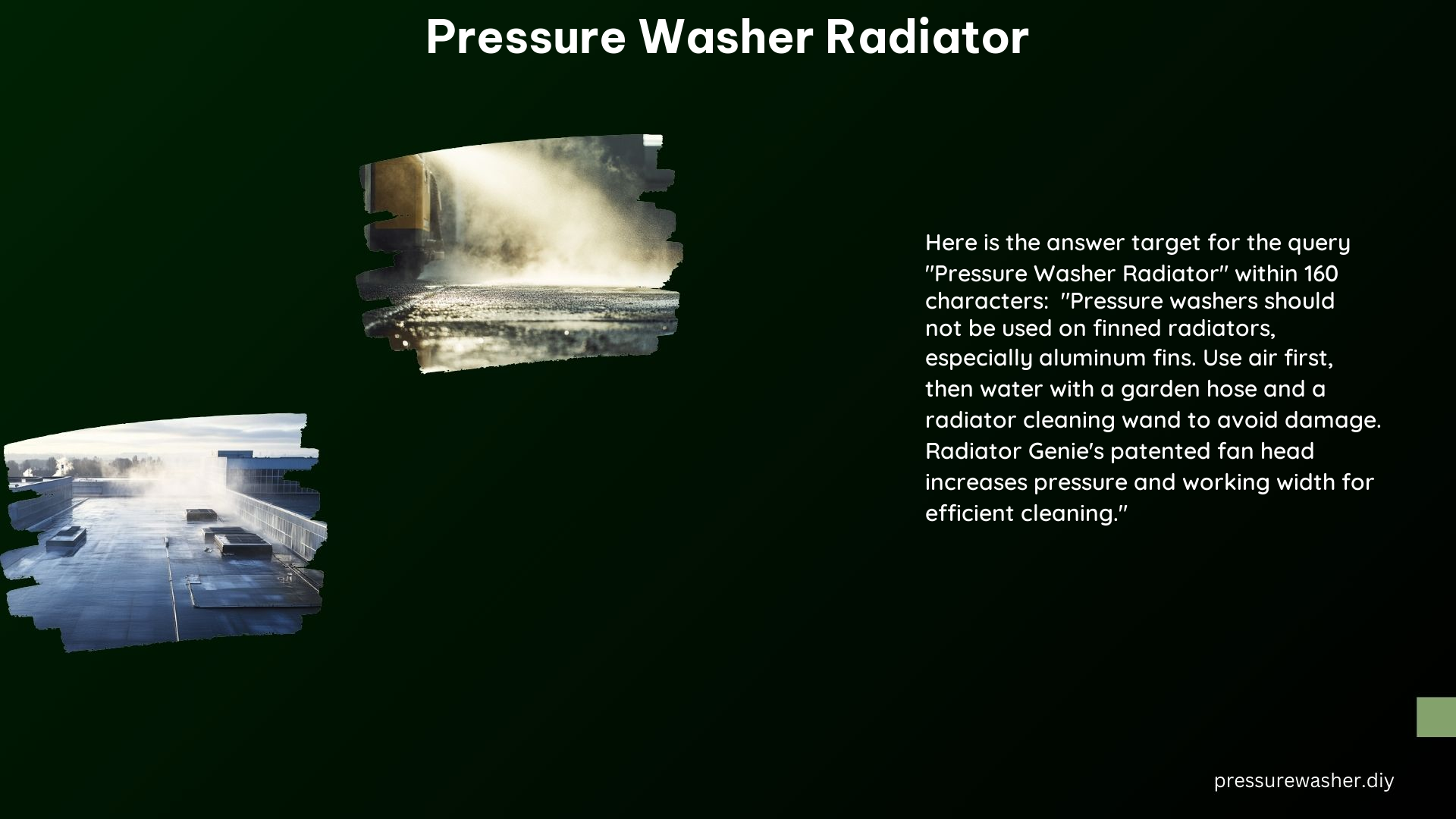Pressure washing a radiator can be an effective way to remove built-up dirt, debris, and grime, but it requires careful consideration to avoid damaging the delicate fins. This comprehensive guide will provide you with the technical details, safety precautions, and step-by-step instructions to clean your radiator using a pressure washer without causing any harm.
Can I Safely Pressure Wash My Radiator?
Yes, you can safely pressure wash your radiator, but it is crucial to exercise caution and follow proper techniques to avoid damaging the radiator fins. Here are some key points to consider:
-
Avoid High Pressure: High-pressure washers can easily damage the delicate fins on your radiator. It is recommended to use a low-pressure setting, ideally below 1,000 PSI, to prevent damage. Exceeding this pressure can cause the fins to bend, break, or become misaligned, reducing the radiator’s cooling efficiency.
-
Use the Right Nozzle: Opt for a wide fan tip nozzle to distribute the pressure evenly and prevent concentrated streams that can damage the fins. A 25-degree or 40-degree nozzle is typically recommended for radiator cleaning.
-
Keep the Nozzle at a Safe Distance: Maintain a safe distance of at least 12 inches between the nozzle and the radiator fins to prevent direct impact. Closer proximity can lead to fin damage and potential leaks.
-
Use a Radiator Cleaning Wand: Specialized radiator cleaning wands, such as the Radiator Genie, are designed to clean radiators safely and effectively. These wands typically have a patented fan head that increases pressure and working width for maximum cleaning without damaging the fins.
-
Clean from the Outside In: Start cleaning from the outside of the radiator and work your way inwards to prevent pushing debris further into the radiator. This approach helps ensure that any dislodged debris is flushed out of the radiator, rather than being pushed deeper into the core.
-
Use Air First: Before using water, use compressed air to remove loose debris. This helps prevent pushing debris further into the radiator and reduces the risk of damage.
What Pressure Setting Should I Use to Clean My Radiator?

The recommended pressure setting for cleaning a radiator is below 1,000 PSI. This lower pressure ensures that the delicate fins are not damaged during the cleaning process. It’s important to note that the exact pressure setting may vary depending on the size and condition of your radiator, as well as the specific pressure washer you are using.
As a general guideline, start with a lower pressure setting, such as 500-800 PSI, and gradually increase the pressure if necessary, while closely monitoring the condition of the radiator fins. Avoid exceeding 1,000 PSI, as this can lead to fin damage and potentially compromise the radiator’s performance.
Will Pressure Washing Damage My Radiator Fins?
Yes, pressure washing can damage your radiator fins if not done correctly. High-pressure streams can bend or break the fins, which can lead to reduced cooling efficiency and potentially cause the radiator to fail. To avoid damage, follow the guidelines mentioned above, including using a low-pressure setting, the right nozzle, and keeping the nozzle at a safe distance.
It’s also important to note that the condition of your radiator plays a role in its susceptibility to damage. Older or more fragile radiators may be more prone to fin damage, even with careful pressure washing. If you’re unsure about the condition of your radiator, it’s best to consult a professional or consider alternative cleaning methods, such as using compressed air or a specialized radiator cleaning solution.
Technical Specifications of Pressure Washer Radiator
When it comes to pressure washing a radiator, the Radiator Genie is a popular and effective tool. Here are the technical specifications of this specialized radiator cleaning wand:
Radiator Genie:
– Overall length: 22.5 inches
– Nozzle length: 17 inches
– Handle material: Nylon
– Compatibility: Air and water
– Part number: RG1001
– UPC: 022742010734
The Radiator Genie’s patented fan head design helps to distribute the pressure evenly across the radiator fins, ensuring maximum cleaning without causing any damage. The long nozzle allows you to reach deep into the radiator core, while the nylon handle provides a comfortable and secure grip during the cleaning process.
DIY Tips for Pressure Washing a Radiator
-
Use a Radiator Cleaning Wand: Invest in a specialized radiator cleaning wand like the Radiator Genie, which is designed to clean radiators safely and effectively. These wands are engineered to provide the optimal balance of pressure and coverage for radiator cleaning.
-
Clean from the Outside In: Start cleaning from the outside of the radiator and work your way inwards to prevent pushing debris further into the radiator. This approach helps ensure that any dislodged debris is flushed out of the radiator, rather than being pushed deeper into the core.
-
Use Air First: Before using water, use compressed air to remove loose debris. This helps prevent pushing debris further into the radiator and reduces the risk of damage.
-
Keep the Nozzle at a Safe Distance: Maintain a safe distance of at least 12 inches between the nozzle and the radiator fins to prevent direct impact. Closer proximity can lead to fin damage and potential leaks.
-
Monitor Pressure and Fin Condition: Regularly check the pressure setting and closely observe the condition of the radiator fins during the cleaning process. If you notice any signs of damage, such as bending or misalignment, immediately reduce the pressure or switch to a different cleaning method.
By following these DIY tips and the safety guidelines outlined earlier, you can effectively clean your radiator using a pressure washer without compromising its performance or longevity.
Reference:
- https://radiatorgenie.com/products/radiator-genie
- https://www.amazon.com/Radiator-Genie-Cleaning-Efficiency-Radiators/dp/B01NAU8J6D
- https://www.monacoers.org/topic/7187-pressure-washing-a-radiator/
- https://www.amazon.com/radiator-cleaning-wand/s?k=radiator+cleaning+wand
- https://talk.newagtalk.com/forums/thread-view.asp?tid=787081&DisplayType=flat&setCookie=1
